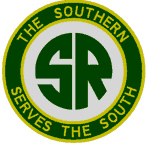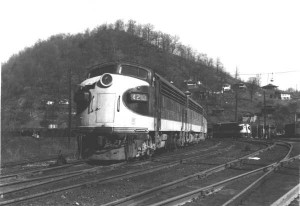- Size: 13′ x 14′
- Scale: HO
- Minimum Radius: 24″
- Minimum Aisle Width: 33″
- Designed by Dan Bourque
 The St Charles branch can be found in extreme southwestern Virginia. A neighbor of the Interstate Railroad, the lines of this branch extended from the Southern’s yard at Appalachia, Virginia, down the Powell River, and then fingered out along several creeks up toward the Kentucky border. Like many other Southern Railway coal lines, it was jointly operated with the L&N who had trackage rights on the St Charles branch from its connection at Pocket, VA. Traffic and tipples ebbed and flowed over the years, but CSX and NS unit trains continue to load on the line.
The St Charles branch can be found in extreme southwestern Virginia. A neighbor of the Interstate Railroad, the lines of this branch extended from the Southern’s yard at Appalachia, Virginia, down the Powell River, and then fingered out along several creeks up toward the Kentucky border. Like many other Southern Railway coal lines, it was jointly operated with the L&N who had trackage rights on the St Charles branch from its connection at Pocket, VA. Traffic and tipples ebbed and flowed over the years, but CSX and NS unit trains continue to load on the line.
The Layout
This layout is designed to represent the end of the St Charles branch in the 1960s and 70s before the flood loaders took the place of the truck dumps and the last of the dilapidated timber and sheet-metal siding tipples. It’s designed to fit into a modest sized bedroom–one of the bedrooms in my house, as a matter-of-fact. It is designed as a series of four vignettes on two decks capturing the more interesting areas of the branch from Pocket to Imperial, the end of the line. The lowest deck represents Pocket, VA, the connection with the L&N and home to several small truck-dump loaders. It also includes the L&N’s short bridge and tunnel, one of the more interesting scenic elements in the area. I’ve also included Osborne, the next loader up the line toward St Charles. From there, the line snakes across the back of the layout and pops out again at the wye at St Charles. St Charles was home to a three-track yard, depot and engine track for the mine run that worked the branch. The unmodeled leg of the wye goes to Mayflower, home of a good-sized tipple and now a flood loader, but I had to sacrifice something.
After traversing a three-turn helix, the scene resumes at Turners Siding where the short Kemmerer Branch left the main. The older Kemmerer Gem No 2 tipple is modeled along with the newer Ralph Baker coal (truck dump). I’ve also included the small truck dump off Turners Siding even though it’s probably a bit modern for the era of the layout. The final scene is Imperial (site of a torn down tipple) and the spur up to Benedict, a formerly large operation pressed back into service during the coal boom though some of the tracks have been removed.
The minimum radius is 24″, but 27″ was used on most visual track. Because this line was served predominantly by 4-axles and coal hoppers, 24″ should work fine operationally. There is a decent bit of compression within the scenes, but the track layouts are close to the prototype. A staging level holds three tracks in a reversing loop for the Southern and two tracks for the L&N which should be plenty for prototypical operations. Tracks are long enough to hold trains of about 25 cars for the Southern and 18-20 cars for the L&N. This layout would work well with a medium-sized DCC system with walk-around controls–DCC would simplify the wiring and allow the L&N and Southern to simultaneously operate trains on the layout.
Operations
While this layout could be operated by a single person, 2-3 would be ideal. In the era modeled, this area was served daily by a scheduled L&N turn (179/180) and a single scheduled Southern turn (61/60) daily. Based on 61/60s short time in St Charles, the mines must have been served by a local mine run based out of St Charles which is how operations on this layout are envisioned. L&N 179 from Pennington, VA, powered by a pair of RS3s or C420s, would enter the scene first at Pocket around 6AM and make its way to St Charles where it had 3.5 hours by the timetable to work any loaders up the branch delivering to the L&N. In the meantime, the Southern’s train 61 would leave Appalachia and arrive at Pocket around 7AM. 61 would run through Pocket and stop at St Charles to deliver empties and pick up the loads from the night prior before heading back toward Appalachia at 9:45 as train 60. From there, the St Charles mine run would take over, switching the busy loaders at Pocket and any other tipples up the branch delivering to the Southern. Southern power, both for 61/60 and the St Charles mine run, would be either a set of grungy F-units in the ’60s (with perhaps a GP7 thrown in) or 2-3 GP38s in the ’70s (with the occasional GP30 or 35 thrown in by mid-decade).
 Both the L&N and St Charles mine run would have their hands full with the myriad of loaders, short tracks, lack of run-arounds and stub arrangements. On top of that, one of the crews would have to play dispatcher to keep the two from running into each other. I imagine it would take between 2 and 3 hours to complete a full operating session–not bad for a bedroom-sized layout! Pocket alone would probably take 45 min to work. It would be easy to change up the operations by varying which mines were shipping on which railroad (some might even ship to both), and by “idling” a loader or two.
Both the L&N and St Charles mine run would have their hands full with the myriad of loaders, short tracks, lack of run-arounds and stub arrangements. On top of that, one of the crews would have to play dispatcher to keep the two from running into each other. I imagine it would take between 2 and 3 hours to complete a full operating session–not bad for a bedroom-sized layout! Pocket alone would probably take 45 min to work. It would be easy to change up the operations by varying which mines were shipping on which railroad (some might even ship to both), and by “idling” a loader or two.
Things I Like About this Plan:
- Lots of operation in a small space
- Two railroads
- Tons of coal loaders of various sizes and shapes (fun modeling)
- No duck-unders
Things I Don’t Like About this Plan:
- 24″ radius
- Very compressed in places
- Lots of difficult-to-hide transitions into the backdrop
- Limited staging
- Only coal–not much variety in car types
Related Products:






Dan, one of your best track plans yet, and I’ve been following them for the past 13 years. I’m still learning a lot about the Southern/ L&N operations in Wise County/Intersate country and had not quite grasped until today that the two operated jointly on the St. Charles Branch. What a great prototype to model!
My gut impression is that track plan is very doable. Trees can help mask the transitions; 24-inch radius curves, while tight for HO, enhance the branchline flavor.
Better yet, this plan could be done in N scale, retaining the same footprint for the right of way. Atlas Geep 38s and C420s run like jewels and would look great on “broad” curvature!
Thanks,Paul! This really is a neat branch, but it’s been “undercovered” compared to many others. The L&N’s role on the branch ebbed and flowed. There are pictures from the late ’60s of the local with a single RS3, half a dozen hoppers and a cab. Perfect sized train for a bedroom!
Love this branch line operation. I’m trying to figure out how to do it all on a single level in a larger room. Staging hidden behind the back drop, etc. Thanks for posting this, Dan.
This is a tough branch to model on one level because it’s like a big tree trunk that breaks into smaller and smaller branches. I’ve found double-deck designs to handle that kind of line more easily. Let me know if you figure out a good way to do it on a single deck.